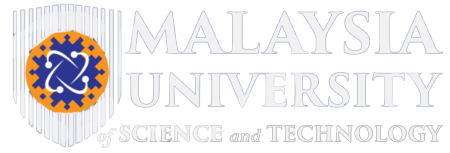:: Journal Menu
:: Related Links
Published by
Malaysia University of Science and Technology
::Submission Guidelines
We aim to present these journal articles in a consistent, high-quality format. To facilitate this, we request that authors adhere to a few simple guidelines. Essentially, your paper should match the format of this document. The easiest way to ensure this is by downloading the provided template and replacing the content with your own material. State the background, a short literature survey and objective(s) in Introduction section. Ensure that technical terms are explained unless they are widely recognized within the community. Clearly identify the corresponding author. Your manuscript should contain, at a minimum, the following sections: Introduction, Method, Results and Discussion, Conclusion, and References.
1 / Style and Layout
1.1 Page Size and Page Limits
All material on each page should be centered on an A4 size (8.26 x 11.69 inch, or 21 x 29.7 cm) page. The following margin settings in MS Word will produce the correct result, for A4 size paper: top 1 inch (2.54 cm); bottom: 0.8 inch (2.03 cm); left and right: 1 inch (2.54 cm). It is important to check the margins even if you use this template, because they might have been overwritten by your local settings. Page limit for full paper is 10 to 15 pages.
1.2 Format and Layout
Please use Times New Roman as default font type and single line spacing throughout the document. 11-point Times New Roman is the recommended type of font for running text. Keep all text aligned justified, and only centre the paper title, author’s name and affiliation, and captions and legends of illustrations. Start a new paragraph without indenting and add space before paragraph.
1.2.1 Paper Title
Please leave one blank Normal (11 point) line on the title page, then type the title (22 point bold), leave another one Normal line blank, and type the author’s name and affiliation.
Leave another one blank normal line before the Abstract. The Abstract should begin with the word “Abstract:” in bold and should be formatted in the “Abstract” style provided in this template (10 point and indented 0.5 inch, or 1.27 cm, each side) and type the abstract. The abstract (within 350 words) should be a concise statement of the problem, approach, findings, and conclusions of the work described.
Place one blank normal line after the abstract, followed by the word “Keywords:” in bold, followed by a set of keywords, this being also formatted in Abstract style. The keywords should be chosen to be suitable for both an index of the proceedings and for electronic search. Leave two normal lines blank before starting the first paragraph.
1.2.2 Headings and Sub-Headings
First-level Headings (1, 2, 3, …) should be preceded by two blank lines and followed by one blank line, and please keep headings flush left. Sub-headings (1.1, 1.2, 2.1, 2.1.1, …) should be preceded by one blank line and followed by one blank line, and please keep headings flush left.
Number headings and sub-headings consecutively in Arabic numbers and type them in bold and italics respectively.
1.2.3 Lists
For lists, bulleted lists, and numbered lists, please use the MS Word styles “List,” “List 2,” “List Bullet,” “List Bullet 2,” “List Number,” “List Number 2,” etc. See example of List Bullet in this paper.
In general, use of styles rather than manual formatting is preferable to enable us to give the proceedings a uniform appearance.
1.2.4 References and Citations
Use American Psychological Association (APA) 7th edition to format in-text citations, e.g., Jonassen et al. (1999), or (Jonassen et al., 1999), and the reference list at the end of each paper, under the heading References. A quick reference on APA 7 style is available on: https://apastyle.apa.org/
References should be published materials accessible to the public. Internal technical reports may be cited only if they are easily accessible (i.e., you give an URL within your reference). Private communications should be acknowledged, not referenced, e.g., “(Robertson, personal communication).”
1.2.5 Page Numbering, Headers, and Footers
Do NOT include headers, footers, or page numbers in your submission. These will be added when the publications are assembled.
2 / Illustrations
2.1 General
Number tables and figures consecutively, not section-wise.
Do not assemble illustrations at the back of your article, but incorporate them in the text, as close as possible to the first reference.
Illustrations should be centered on the page, except for very small figures (max. width 7 cm), which may be placed side by side. Centre figure captions below the figure, table captions above the table.
2.2 Tables
Number tables consecutively in accordance with their appearance in the text. Place a table’s caption above the table’s body and its description below the body. Avoid vertical rules. Be sparing in the use of tables and ensure that the data presented in tables do not duplicate results described elsewhere in the article.
For example:

You may resize the tables to fit the page size.
2.3 Figures
Number figures consecutively in accordance with their appearance in the text. Place a figure’s caption and description below the figure body. A minimum resolution of 300 DPI is required. You may resize the figures or schemes to fit the page size.

Note. Avoid abbreviating the titles of tables, figures, and equations (i.e., Tab. 1, Fig. 2, Eq. 3) in the caption or in running text. Do not write “the table above/below” or “the figure on page 32,” because the position and page number of a table or figure cannot be determined until the pages are typeset.
2.3 Color
Avoid using images with a black or very dark background whenever possible. Do make sure that all graphics look good in black and white. You may use colored figures.
3 / Language, Style, and Content
Please make sure that your paper is written in clear, readable, proper English. Have it reviewed by a professional technical writer or native English speaker.
The written and spoken language of article in English. Spelling and punctuation may consistently use any dialect of English (e.g., Australian, British, Canadian, or US). Hyphenation is optional. Please write for an international audience:
Write in a straightforward style. Use simple sentence structure. Avoid long sentences and complex sentence structures if possible. Use semicolons sparingly or not at all.
Use common and basic vocabulary (e.g., use the word “unusual” rather than the word “arcane”).
Briefly define or explain all academic and technical jargons.
Expand all acronyms the first time they are used in your text.
Explain local references. For example, not everyone knows all city names in a particular country, and the names of different levels of schooling may differ between countries.
Use unambiguous forms for culturally localized concepts, such as times, dates, currencies and numbers (e.g., “1-5-99” or “5/1/99” may mean January 5th or May 1st, and “seven o’clock” may mean 7:00 am or 19:00).
Be careful with the use of gender-specific pronouns (he, she) and other gendered words (chairman, manpower, man-months). Use inclusive language (e.g., she or he, s/he, they, chair, staff, staff-hours, person-years) that is gender-neutral. See Schwartz et al. (1995) for further advice and examples regarding gender and other personal attributes.
Contact Details
For further information, please contact:
Editor-in-Chief
Malaysia University of Science and Technology (MUST)
Block B, Encorp Strand Garden Office
No. 12, Jalan PJU 5/5, Kota Damansara
47810 Petaling Jaya, Selangor.
Tel : 03-6150 8177
E-mail: ips@must.edu.my


